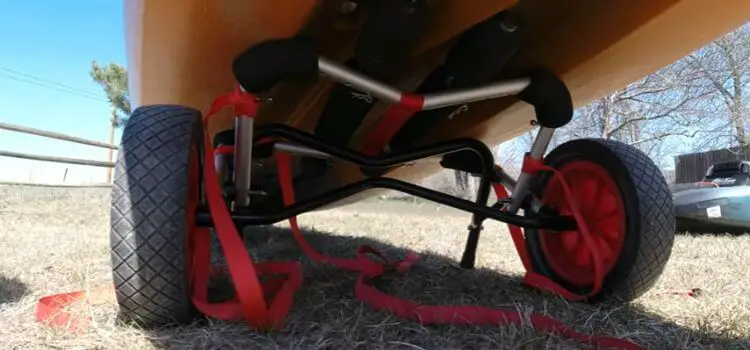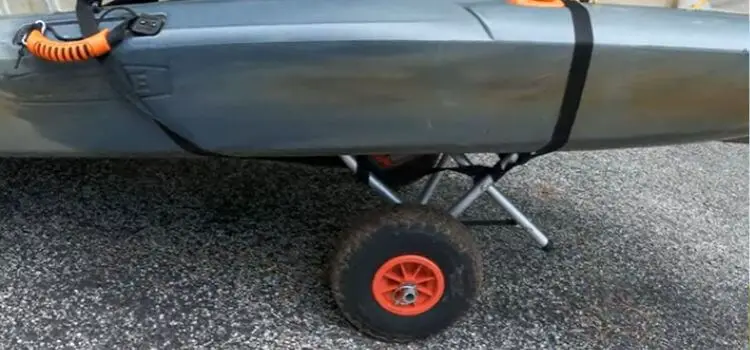As an Amazon Associates, I earn from quality purchases.
Are you interested in learning how to effectively use a kayak cart? If you’re wondering, “How to use a kayak cart,” you’re in the right place. Kayak carts are invaluable tools that make transporting your kayak to and from the water a breeze.
In this article, we will guide you through the step-by-step process of using a kayak cart. We also discuss proper setup, attaching your kayak securely, and navigating various terrains. Mastering the use of a kayak cart will enhance your kayaking experience and make transportation hassle-free.
So, let’s get started and discover the secrets of utilizing a kayak cart effectively.
What is a Kayak Cart?

A kayak cart is a device designed to transport a kayak from one location to another. It typically consists of a frame made of sturdy materials like aluminum, steel, or plastic. It has wheels that enable the kayak to be rolled instead of being carried by hand.
Kayak carts come in different types, including sit-on-top and sit-in kayak carts, to fit the design of the kayak being transported. They are particularly useful for individuals who want to transport their kayaks over longer distances or across rough terrain. They help to reduce the physical strain associated with carrying a kayak manually.
By using a kayak cart, kayakers can move their kayaks with greater ease and convenience. It can enhance their overall kayaking experience.
Why Use a Kayak Cart?
There are several advantages to using a kayak cart:
Reduces physical strain:
Kayaks can be heavy and awkward to carry, especially over long distances or rough terrain. Using a kayak cart can help reduce the physical strain on your body. It allows you to transport your kayak with greater ease and comfort.
Increases convenience:
Kayak carts are designed to be easy to use and maneuver. It is simple and transports your kayak from one location to another. This can save you time and effort. It allows you to focus on enjoying your kayaking experience rather than struggling with transportation.
Protects your kayak:
Kayak carts are designed to cradle your kayak securely. It prevents the kayak from being damaged during transportation. This can help protect your investment. It ensures that your kayak remains in good condition for years to come.
Enhances versatility:
Kayak carts allow you to transport your kayak to a variety of different locations. It opens up new horizons for exploration and venture. With a kayak cart, you can easily transport your kayak to a nearby lake, river, or ocean. You don’t need to worry about the tedious act of transportation.
Overall, using a kayak cart can make kayaking more enjoyable and accessible. It allows you to spend more time on the water and less time worrying about transportation.
Types of Kayak Carts
There are several different types of kayak carts available on the market. Each one is designed to meet the specific needs and preferences of kayakers. Below here are some common types of kayak carts:
Sit-on-top kayak carts:
These carts are specifically designed for transporting sit-on-top kayaks. They feature a V-shaped cradle that holds the kayak securely. It prevents the kayak from slipping or sliding during transportation. The wheels are large and wide. They are suitable for transporting kayaks across different types of terrain.
Sit-in kayak carts:
These carts are designed for transporting sit-in kayaks. They feature a U-shaped cradle that fits around the hull of the kayak, holding it securely in place. The wheels are smaller and narrower than sit-on-top kayak carts, making them better suited for smoother surfaces.
Folding kayak carts:
These carts are designed to be compact and portable. They are ideal for kayakers who need to transport their kayaks over long distances or rugged terrain. They can be folded down for easy storage and transport, and feature smaller wheels that are more maneuverable.
Beach kayak carts:
These carts are designed for use on sandy beaches. They feature large, wide wheels. These wheels can easily navigate through the sand. They have specialized features like balloon tires or oversized rims to provide additional flotation.
Electric kayak carts:
These carts are powered by an electric motor. It allows kayakers to transport their kayaks with minimal physical effort. They feature larger, heavier frames to accommodate the motor. They may have additional features like a rechargeable battery or adjustable speed settings.
No matter what type of kayak cart you choose, it’s important to select one that is compatible with the size and weight of your kayak, as well as the terrain and conditions you will be navigating.
Choosing the Right Kayak Cart

Choosing the right kayak cart is essential if you want to ensure that your kayaking experience is safe and enjoyable. Here are some factors to consider when selecting a kayak cart:
Weight capacity:
The weight capacity of the cart is one of the most important factors to consider. Make sure that the cart you choose can support the weight of your kayak and any additional gear you may be carrying.
Wheel size:
The size of the wheels on the cart can affect how well it can navigate different terrains. Larger wheels are generally better for rough terrain, while smaller wheels are better for smoother surfaces.
Foldability:
Consider how easy it is to fold the cart for storage and transport. If you have limited storage space, a cart that can be easily collapsed may be a better option.
Material:
Look for a cart made of durable materials, such as aluminum or steel. These materials can withstand the wear and tear of frequent use and exposure to the elements.
Type of cart:
There are two main types of kayak carts: strap-style and plug-style. Strap-style carts use straps to secure the kayak to the cart, while plug-style carts fit into the scupper holes of the kayak. Consider which type of cart will work best for your kayak.
Budget:
Kayak carts can range in price from budget-friendly options to more expensive models with advanced features. Consider your budget and the features that you want to have in your cart before making a decision.
By considering these factors, you can choose the right kayak cart to meet your needs and ensure that your kayaking experience is safe and enjoyable.
Steps to Use a Kayak Cart
Strap Style
If you have decided to use a strap-style kayak cart to transport your kayak, here are the steps you should follow:
Position the kayak cart:
Start by positioning the kayak cart next to your kayak. The cart should be parallel to the kayak, with the wheels facing up.
Secure the straps:
Take the straps that came with your kayak cart and place them over the top of your kayak. Position the straps so that they are evenly spaced, with one strap near the bow and one near the stern.
Secure the kayak:
Carefully lift the kayak and place it onto the kayak cart, making sure that the cart is centered beneath the kayak. Adjust the position of the straps as needed, and then pull them tight to secure the kayak onto the cart.
Adjust the cart:
Once the kayak is securely strapped to the cart, adjust the cart so that the kayak is level and balanced. If the kayak is leaning to one side or the other, adjust the position of the cart or the straps until the kayak is properly balanced.
Roll the cart:
With the kayak securely strapped to the cart, you are now ready to transport it to your desired location. Grab the handle of the cart and begin rolling it forward, keeping the kayak level and balanced as you go.
Monitor the straps:
As you roll the cart, make sure to periodically check the straps to ensure that they remain tight and secure. If the straps become loose, stop and re-tighten them before continuing.
Unstrap the kayak:
When you reach your destination, carefully lift the kayak off of the cart and remove the straps. Store the straps in a safe place until you are ready to use them again.
By following these simple steps, you can use a strap-style kayak cart to transport your kayak with ease and convenience, ensuring that you can fully enjoy your kayaking experience.
Plug Style
If you have a plug-style kayak cart, which is designed to fit into the scupper holes of your kayak, here are the steps you should follow:
Position the kayak cart:
Start by positioning the kayak cart next to your kayak. The cart should be parallel to the kayak, with the wheels facing up.
Remove the scupper plugs:
Remove the scupper plugs from the scupper holes in the kayak. This will allow you to insert the cart into the holes.
Insert the cart:
Carefully insert the cart into the scupper holes, making sure that the cart is centered beneath the kayak.
Adjust the cart:
Once the kayak is securely on the cart, adjust the position of the cart so that the kayak is level and balanced. If the kayak is leaning to one side or the other, adjust the position of the cart until the kayak is properly balanced.
Roll the cart:
With the kayak securely on the cart, you are now ready to transport it to your desired location. Grab the handle of the cart and begin rolling it forward, keeping the kayak level and balanced as you go.
Monitor the kayak:
As you roll the cart, make sure to periodically check the kayak to ensure that it remains securely in place. If the kayak becomes loose, stop and adjust the cart before continuing.
Remove the cart:
When you reach your destination, carefully lift the kayak off of the cart and remove the cart from the scupper holes. Replace the scupper plugs in the holes to prevent water from entering the kayak.
Following these simple steps, you can transport your kayak with ease and convenience. It ensures that you can enjoy your kayaking experience to the fullest.
Best Ways to Maintain the Kayak Cart

Proper maintenance of your kayak cart is essential to ensure its longevity and optimal performance while using it. Here are some key tips to maintain your kayak cart:
Regular Cleaning:
Every time after using the cart, clean it to remove any dirt, sand, or debris that may have been attached to it. Rinse it thoroughly with fresh water to prevent corrosion or damage caused by saltwater or contaminants.
Check for Damage:
Inspect the cart for any signs of damage, such as cracks, bent parts, or loose fittings. Address any issues promptly to prevent further deterioration and potential failure during use.
Lubrication:
Apply lubricant to the cart’s moving parts, such as wheels and axles, to ensure smooth operation. This helps reduce friction, prevents rust, and extends the lifespan of the cart.
Tire Maintenance:
Check the tires, and ensure they are properly inflated. Underinflated tires can affect the cart’s stability and maneuverability. Also, inspect the tires for any punctures or damage, and replace them if necessary.
Secure Straps and Fasteners:
Verify that all straps, buckles, and fasteners are securely tightened before using the cart. Loose or damaged straps can compromise the stability and safety of the kayak while in transit.
Store Properly:
When not in use, store the kayak cart in a clean, dry area away from direct sunlight. This helps prevent UV damage and extends the life of the cart’s components.
Regular Inspections:
Periodically inspect the cart for any signs of wear, particularly in high-stress areas such as the frame or attachment points. Address any issues promptly to prevent further damage and ensure safe usage.
By following these maintenance practices, you can keep your kayak cart in good condition and ensure it performs reliably while transporting your kayak. Regular upkeep will extend the lifespan of the cart, allowing you to enjoy hassle-free kayak transportation for years to come.
Which Is the Best- Strap or Plug-In?
Whether a strap-style or plug-style kayak cart is best for you, will depend on your personal preferences and the specific requirements of your kayak.
- Strap-style kayak carts are generally more versatile and can be used with a wider range of kayaks. They are also typically easier to use, as they do not require the kayak to have scupper holes.
- On the other hand, plug-style kayak carts provide a more secure and stable fit for kayaks that have scupper holes. They also tend to be more stable on rough terrain, as they fit more snugly into the kayak.
Ultimately, the best type of kayak cart for you will depend on your specific needs and preferences. Consider factors such as the weight of your kayak, the terrain you will be navigating, and your budget when selecting a kayak cart.
Tips for Using a Kayak Cart
- Check the weight limit of your kayak cart before using it to ensure that it can handle the weight of your kayak.
- Use the correct size wheels for the terrain you will be transporting your kayak over.
- Make sure that the kayak is securely attached to the cart and that it does not move around during transportation.
- When transporting your kayak on rough terrain, use caution and go slowly to avoid damaging your kayak.
- Always check the condition of your kayak cart before each use to ensure that it is in good working condition.
Vigilances When Using a Kayak Cart

When using a kayak cart, it’s important to exercise caution to ensure your safety and protect your kayak. Here are some key cautions to keep in mind:
1. Weight Capacity:
Be mindful of the weight capacity of your kayak cart. Exceeding the recommended weight limit can strain the cart and potentially lead to damage or failure. Check the manufacturer’s guidelines and ensure your kayak and gear fall within the specified weight range.
2. Secure Attachment:
Double-check that your kayak is securely fastened to the cart before moving it. Use reliable and properly adjusted straps or tie-downs to prevent the kayak from shifting or falling off the cart during transport.
3. Terrain Awareness:
Pay attention to the terrain you’re navigating while using the cart. Avoid rough, uneven surfaces, steep slopes, or obstacles that may pose a risk to the stability of the cart or the safety of your kayak. Choose a suitable path and be cautious when crossing uneven terrain or challenging obstacles.
4. Balance and Stability:
Maintain a proper balance and weight distribution on the kayak cart. Avoid excessive tilting or overloading one side, as this can cause instability and increase the risk of the kayak tipping over.
5. Maneuvering Carefully:
Take your time and maneuver the kayak cart carefully. Avoid sudden movements, sharp turns, or abrupt stops that can put stress on the cart or cause the kayak to shift unexpectedly.
6. Environmental Considerations:
Consider the weather conditions and environmental factors. High winds, strong currents, or slippery surfaces can impact the stability and control of the kayak cart. Adjust your speed and technique accordingly to maintain control and prevent accidents.
7. Personal Safety:
Prioritize your safety. Wear appropriate footwear and use proper lifting techniques when loading or unloading the kayak onto the cart. Avoid placing yourself in a position where you could strain or injure yourself.
By being cautious and mindful of these factors, you can ensure a safe and smooth experience while using a kayak cart. Always prioritize safety and take the necessary precautions to protect yourself, your kayak, and the cart during transportation.
You may also read: How to Put a Trolling Motor on a Kayak?
Conclusion
Mastering how to use a kayak cart can enhance your kayaking experience by simplifying transportation to and from the water. By following the proper setup and attachment techniques, as well as considering the terrain and weight capacity, you can ensure a smooth and hassle-free journey.
Whether you’re a beginner or a seasoned kayaker, utilizing a kayak cart efficiently is a valuable skill to have. So, take advantage of this essential tool and enjoy the convenience it brings to your kayaking adventures. Discover the secrets of using a kayak cart effectively and make transporting your kayak a breeze.
Frequently Asked Questions (FAQs):
Q: What is a kayak cart?
A: A kayak cart is a small, wheeled device designed to transport kayaks from one location to another.
Q: How do I know which kayak cart to choose?
A: Consider factors such as weight capacity, wheel size, foldability, material, type of cart, and budget when selecting a kayak cart.
Q: What do you do with your kayak cart?
A: A kayak cart is used to transport your kayak from your vehicle to the water and vice versa. It helps you easily move the kayak across different terrains, such as sand, gravel, or grass, without having to carry it by hand.
Q: How do you attach a kayak to a cart?
A: To attach a kayak to a cart, place the kayak on its side and position the cart underneath the hull near the center. Secure the cart to the kayak using straps or tie-downs, ensuring a tight and stable connection. Make sure the kayak is evenly balanced on the cart and that it is securely fastened before moving.
Q: How do you use a canoe cart?
A: Using a canoe cart follows a similar process to using a kayak cart. Position the cart underneath the canoe’s hull, near the center. Secure the cart to the canoe using straps or tie-downs. Ensure that the canoe is well-balanced on the cart and securely fastened before transporting it.
Q: What is the use of a cart?
A: A cart, such as a kayak cart or canoe cart, is used for transporting watercraft from one location to another. It provides an easier and more convenient method of moving kayaks, canoes, or other small boats across various terrains. It saves physical effort and reduces the risk of damage to the watercraft.
Q: How to make a kayak cart?
A: To make a DIY kayak cart, you can start by gathering materials such as sturdy frames, wheels, axles, and straps. Assemble the frame using appropriate measurements and secure the wheels to the axles. Attach straps or tie-downs to the frame for securing the kayak.

Leave a Reply